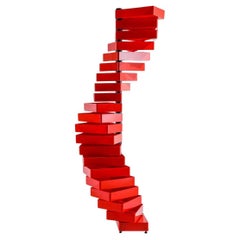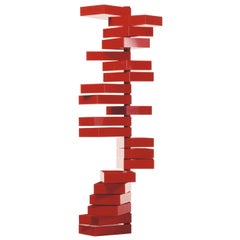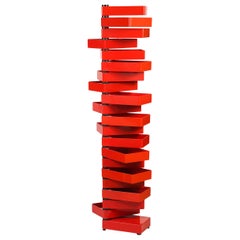Revolving Cabinet Shiro Kuramata
Vintage 1970s Italian Mid-Century Modern Commodes and Chests of Drawers
Steel
Recent Sales
21st Century and Contemporary Italian Modern Cabinets
Acrylic
21st Century and Contemporary Italian Modern Cabinets
Acrylic
Vintage 1970s Italian Mid-Century Modern Cabinets
Metal
2010s Italian Mid-Century Modern Cabinets
Steel
Vintage 1970s Italian Mid-Century Modern Cabinets
Plastic
Shiro Kuramata for sale on 1stDibs
Few designers have blended Minimalism and Surrealism into artistic furniture as successfully as Shiro Kuramata. His experimentation with form, function, color and motif informed cabinets, chairs and side tables that are as mystifying as they are visually striking.
Born in Tokyo in 1934, Kuruamata studied at the Kuwasawa Design School. In the 1970s and ’80s, he explored industrial materials in his designs. Inspired by Italian architect and designer Ettore Sottsass, Kuramata produced irreverent and bold work. In 1981, Kuramata joined Sottsass in his founding of the Memphis Group, named for a Bob Dylan song. The Milan-based collective aimed to turn the status quo on its head and redefine what was considered appealing in modern furniture style.
His experience with the Memphis Group led Kuramata to embrace unconventional optical effects. No piece embodies this more skillfully than the Miss Blanche chair. Crafted with transparent resin and flecked with rose-petal flecks, it gives the illusion that the sitter is floating.
The How High the Moon armchair is a prime example of his playful nature and willingness to challenge the expectations for furniture design. Including shards of colored glass in concrete surfaces, his “star piece” material was prevalent throughout his work, giving the tops of his end tables and coffee tables a brazen, gem-encrusted appearance. His daring approach to design can also be seen in pieces like his sheer glass bookcases with their seemingly fragile shelves.
Kuramata created many visual delights before his death in 1991. His work is in the collections of the Museum of Modern Art and Metropolitan Museum of Art in New York. His pieces remain highly prized by collectors and design enthusiasts worldwide.
On 1stDibs, explore a selection of vintage Shiro Kuramata seating, storage pieces, decorative objects and more.
Materials: Plastic Furniture
Arguably the world’s most ubiquitous man-made material, plastic has impacted nearly every industry. In contemporary spaces, new and vintage plastic furniture is quite popular and its use pairs well with a range of design styles.
From the Italian lighting artisans at Fontana Arte to venturesome Scandinavian modernists such as Verner Panton, who created groundbreaking interiors as much as he did seating — see his revolutionary Panton chair — to contemporary multidisciplinary artists like Faye Toogood, furniture designers have been pushing the boundaries of plastic forever.
When The Graduate's Mr. McGuire proclaimed, “There’s a great future in plastics,” it was more than a laugh line. The iconic quote is an allusion both to society’s reliance on and its love affair with plastic. Before the material became an integral part of our lives — used in everything from clothing to storage to beauty and beyond — people relied on earthly elements for manufacturing, a process as time-consuming as it was costly.
Soon after American inventor John Wesley Hyatt created celluloid, which could mimic luxury products like tortoiseshell and ivory, production hit fever pitch, and the floodgates opened for others to explore plastic’s full potential. The material altered the history of design — mid-century modern legends Charles and Ray Eames, Joe Colombo and Eero Saarinen regularly experimented with plastics in the development of tables and chairs, and today plastic furnishings and decorative objects are seen as often indoors as they are outside.
Find vintage plastic lounge chairs, outdoor furniture, lighting and more on 1stDibs.
Finding the Right Case Pieces And Storage Cabinets for You
Of all the vintage storage cabinets and antique case pieces that have become popular in modern interiors over the years, dressers, credenzas and cabinets have long been home staples, perfect for routine storage or protection of personal items.
In the mid-19th century, cabinetmakers would mimic styles originating in the Louis XIV, Louis XV and Louis XVI eras for their dressers, bookshelves and other structures, and, later, simpler, streamlined wood designs allowed these “case pieces” or “case goods” — any furnishing that is unupholstered and has some semblance of a storage component — to blend into the background of any interior.
Mid-century modern furniture enthusiasts will cite the tall modular wall units crafted in teak and other sought-after woods of the era by the likes of George Nelson, Poul Cadovius and Finn Juhl. For these highly customizable furnishings, designers of the day delivered an alternative to big, heavy bookcases by considering the use of space — and, in particular, walls — in new and innovative ways. Mid-century modern credenzas, which, long and low, evolved from tables that were built as early as the 14th century in Italy, typically have no legs or very short legs and have grown in popularity as an alluring storage option over time.
Although the name immediately invokes images of clothing, dressers were initially created in Europe for a much different purpose. This furnishing was initially a flat-surfaced, low-profile side table equipped with a few drawers — a common fixture used to dress and prepare meats in English kitchens throughout the Tudor period. The drawers served as perfect utensil storage. It wasn’t until the design made its way to North America that it became enlarged and equipped with enough space to hold clothing and cosmetics. The very history of case pieces is a testament to their versatility and well-earned place in any room.
In the spirit of positioning your case goods center stage, decluttering can now be design-minded.
A contemporary case piece with open shelving and painted wood details can prove functional as a storage unit as easily as it can a room divider. Alternatively, apothecary cabinets are charming case goods similar in size to early dressers or commodes but with uniquely sized shelving and (often numerous) drawers.
Whether you’re seeking a playful sideboard that features colored glass and metal details, an antique Italian hand-carved storage cabinet or a glass-door vitrine to store and show off your collectibles, there are options for you on 1stDibs.


